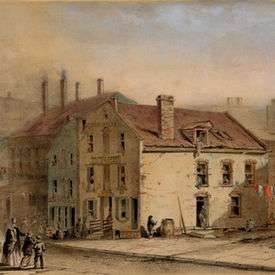The Old Brewery

The Old Brewery was the name given to Coulthard's Brewery (built in 1792, in lower central Manhattan, on land that was then on the outskirts of New York City) after its conversion to a rookery following the Panic of 1837.
The brewery was built by Isaac Coulthard[1] southeast of a body of freshwater known as the Collect Pond. The brewery went to the US Supreme Court in Dewhurst v. Coulthard. After a century of being gradually polluted by industries located on its shores, the Collect Pond was filled in, the project being completed around 1811–1812.
Afterwards, existing streets were extended and new streets laid out on the reclaimed land. Immediately in front of the brewery passed Cross Street in a northeast to southwest direction. Orange Street intersected Cross just north of the brewery. From this intersection, Anthony Street originated and ran northwest, creating a plot of land which ended in a point. This became the infamous Five Points intersection. To the west of this point ran a short street named Little Water Street, which created a triangular plot known as Paradise Park (also known as Paradise Square); the Brewery was across the street from Paradise Park on the south side of Cross Street.
Isaac Coulthard died in 1812 and his son William (also a brewer) died in 1822.[2] Afterward, others ran the brewery, including Joseph Barnes in 1827.[3]
After the financial crisis known as the Panic of 1837, Coulthard's Brewery was converted into residential use and became known as "The Old Brewery". Five Points became a slum within a decade after the filling-in of the Collect Pond, and the Old Brewery became a lawless, overcrowded, filthy and disease-ridden building.
The common descriptions are that around the building extended an alley three feet wide, which led to a room called the Den of Thieves. Seventy-five men, women and children, black and white, made their homes there without furniture or other amenities. Many women were prostitutes and conducted their business there. On the opposite side the passageway was known as Murderers Alley and was all that the name implied. The cellars of the Old Brewery were divided into twenty rooms which had previously been used for storage of machinery and there were about seventy-five other chambers above ground. During its greatest period the building housed over 1,000 men, women and children. According to historian Herbert Asbury, demolition crews found human bones in the cellars and within the walls.[4]
The Old Brewery was purchased in 1852 by the Methodist Ladies of the Mission; it was demolished in December 1853 and a new building called the New Mission House at the Five Points was erected. Over forty years later, this mission house would itself be replaced by a newer, even bigger one.[5][6]
In popular culture
The Old Brewery is depicted in the 2002 film Gangs of New York and the 2012 video game Assassin's Creed III.
References
- ↑ Shirley Wade Baron, Brewed in America: A History of Beer and Ale in the United States (1962)
- ↑ Barber, Gertrude A. (1933–47). "All New York, Death Newspaper Extracts, 1801-1890". Deaths taken from the New York Evening Post. Volumes 1-54. n.p.: n.p.
- ↑ Longworth, David (1827). "1827-1828 Longworth's New York Directory". Longworth’s American Almanac: New York Register and City Directory. Retrieved 14 May 2014.
- ↑ The Gangs of New York: An Informal History of the Underworld By Herbert Asbury (1927, 1928 Alfred A. Knopf, Inc.) p.13
- ↑ Ladies of the Mission, The Old Brewery and the New Mission house at the Five Points, pp. 33–38 (1854)
- ↑ New York Times: New Five Points Mission;Work of Demolishing the Old Structure Begun